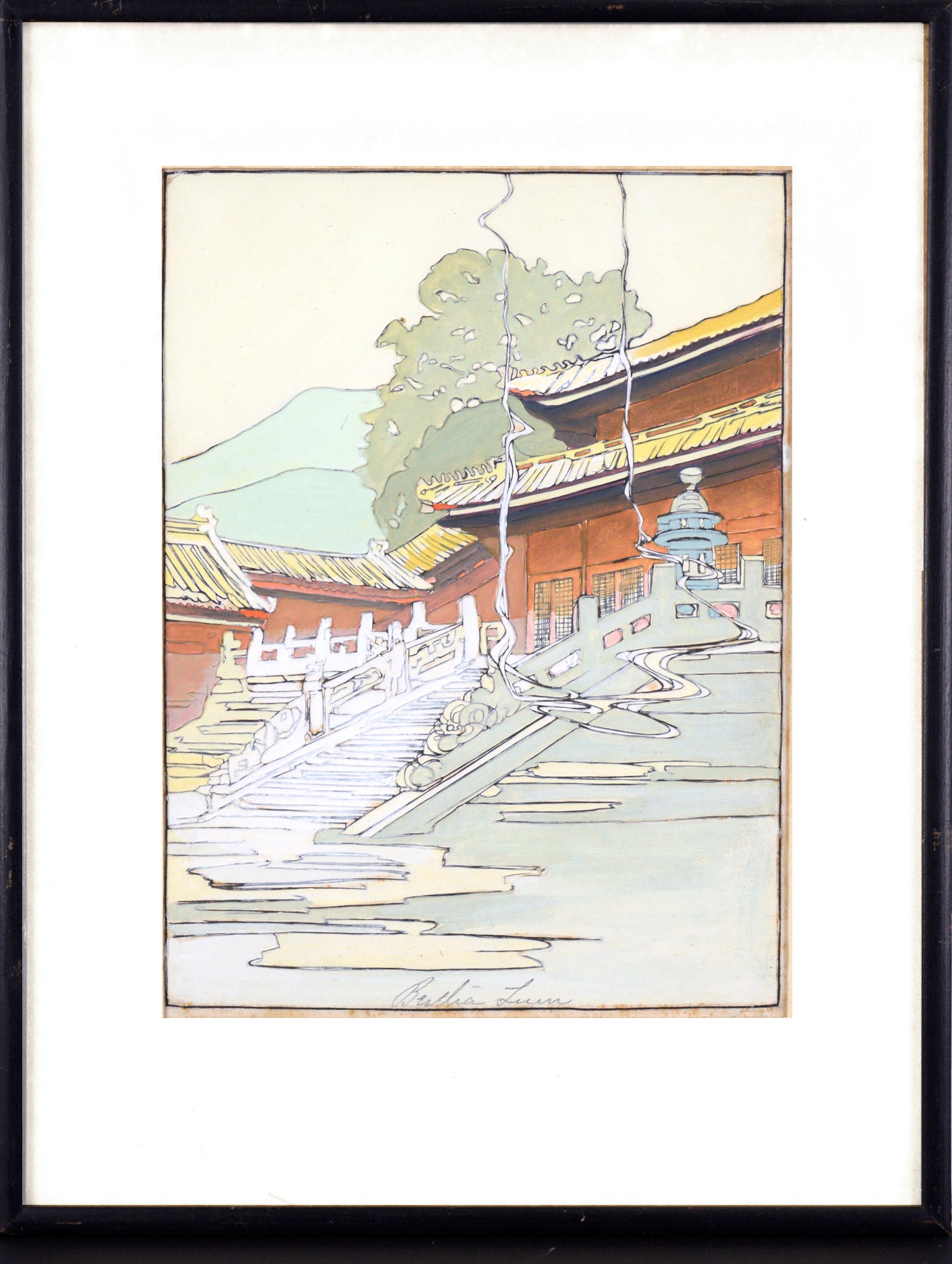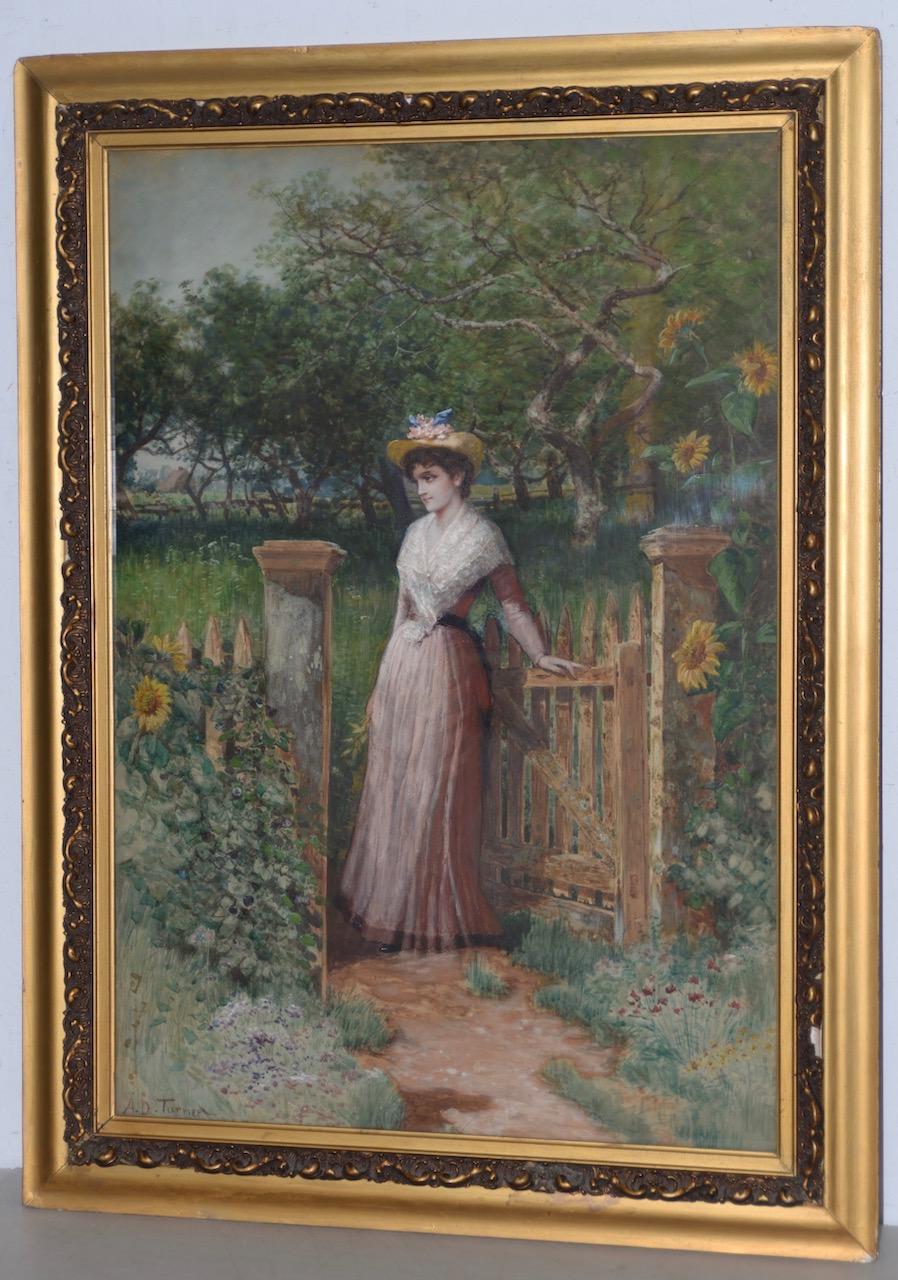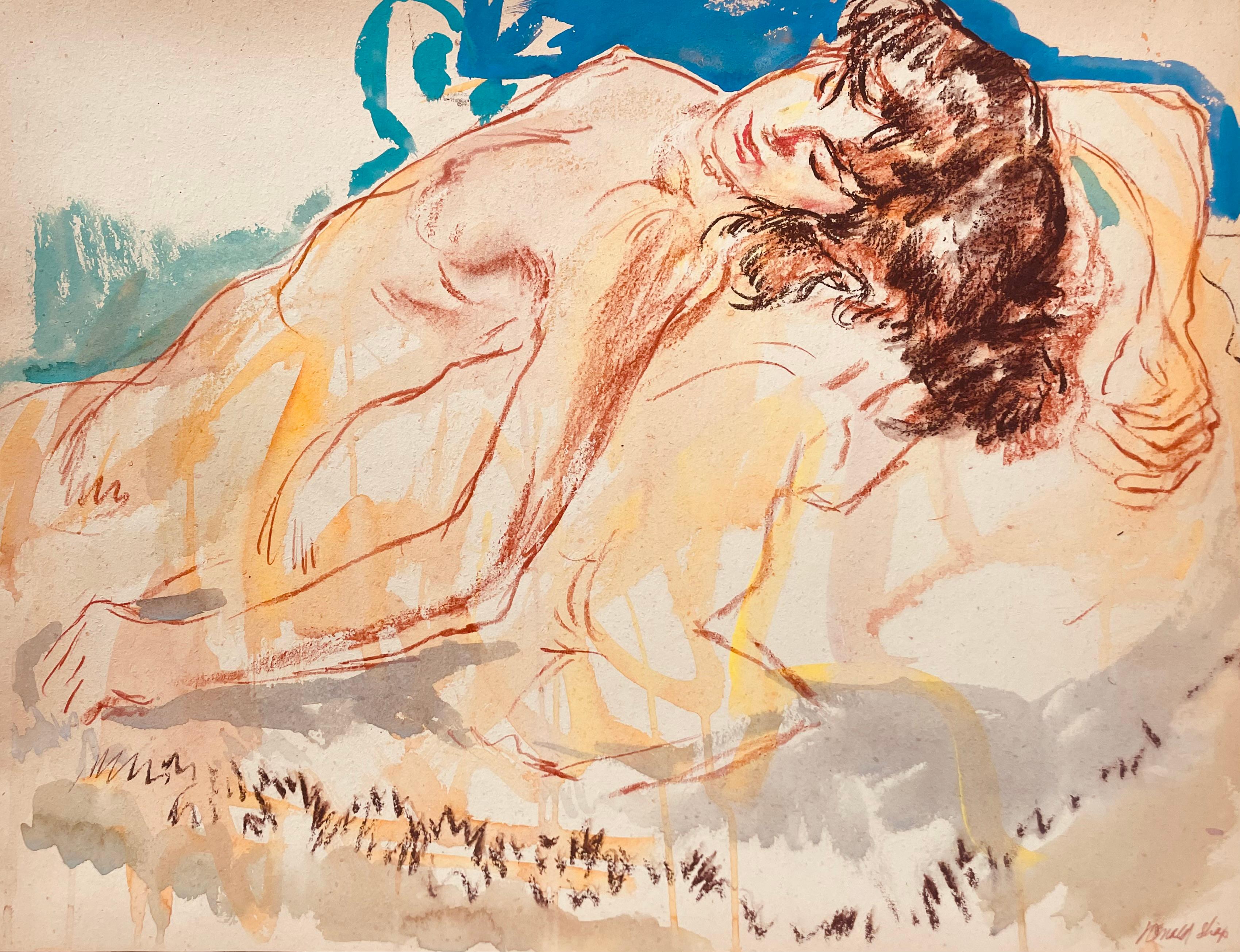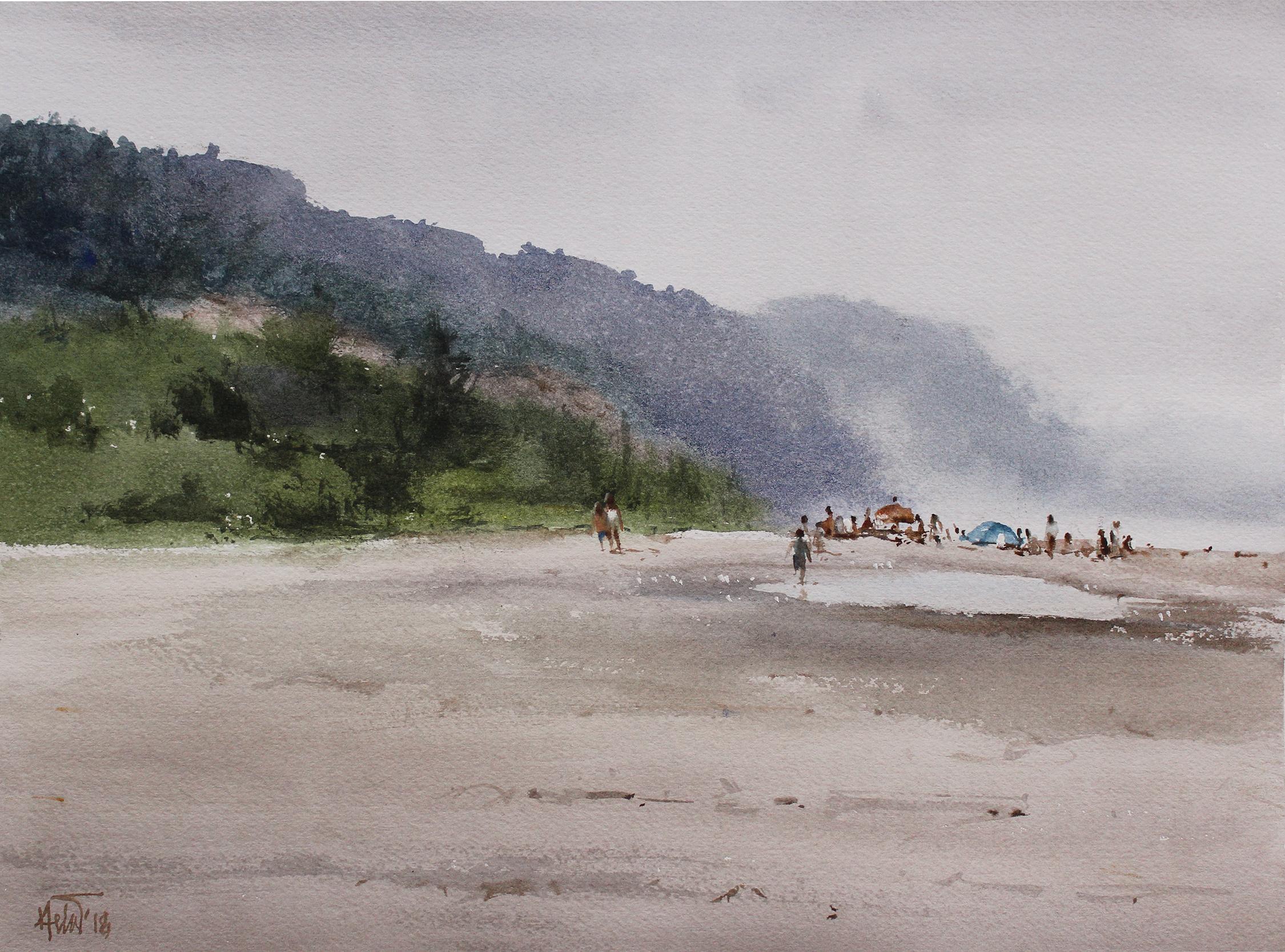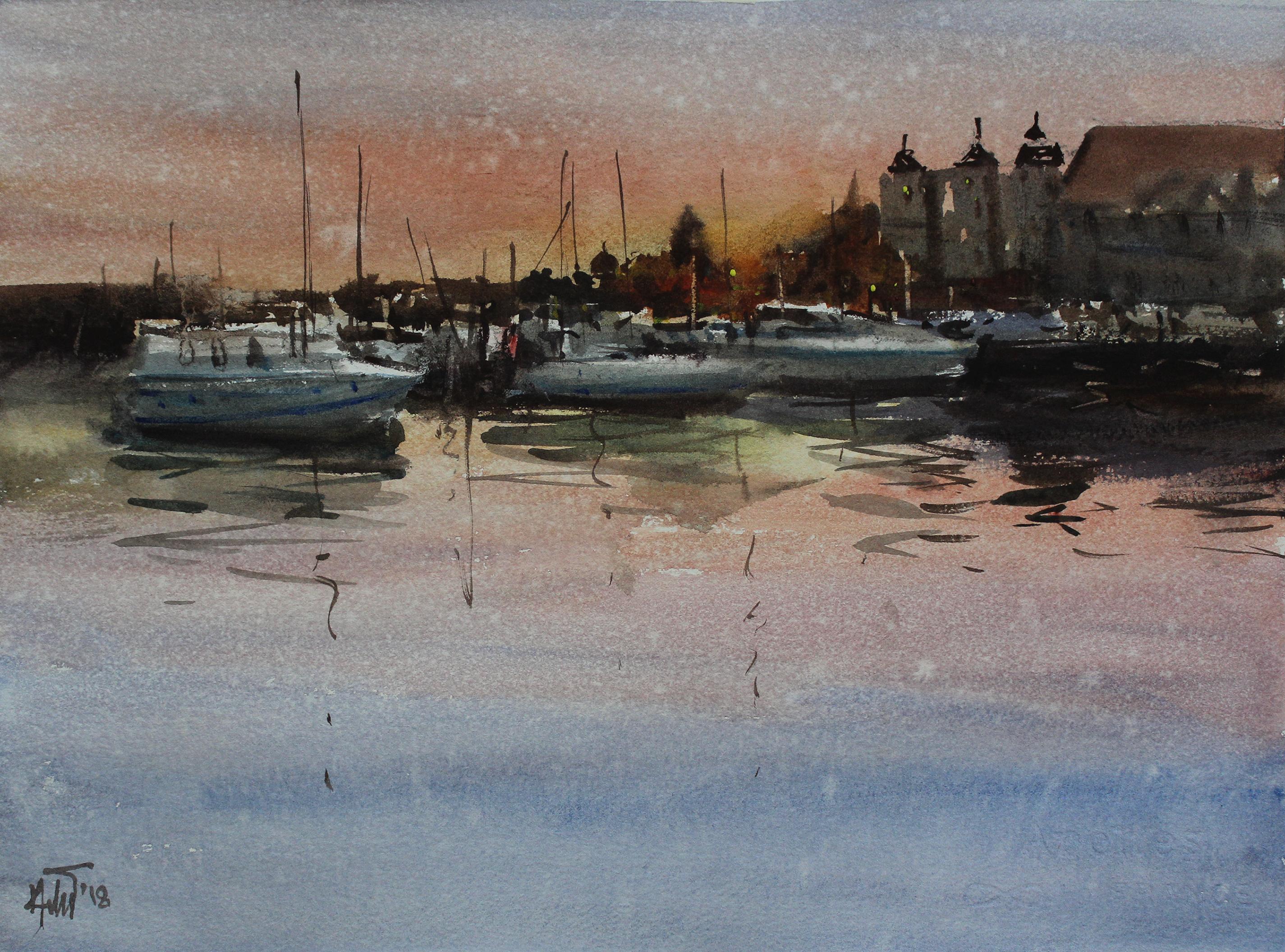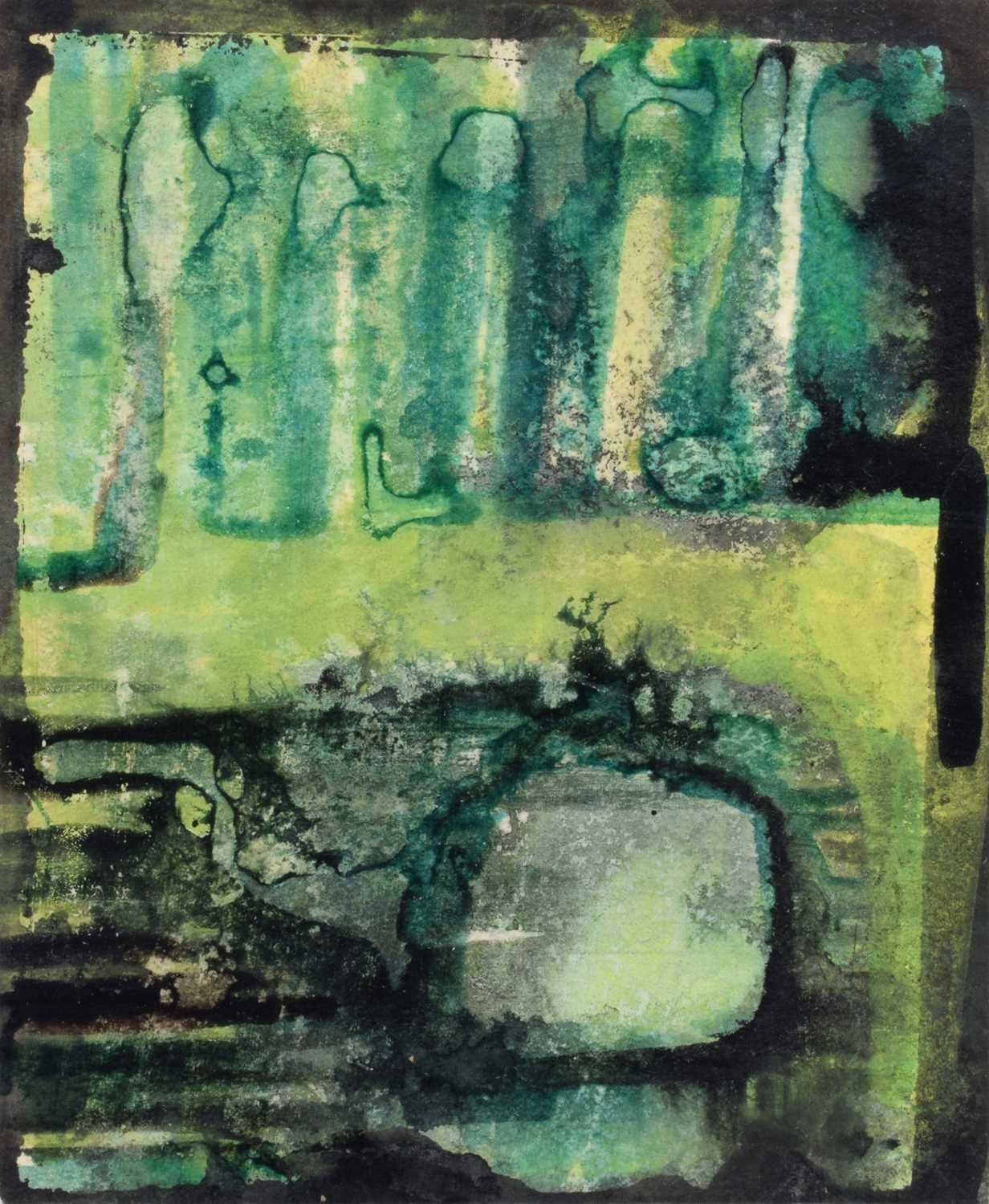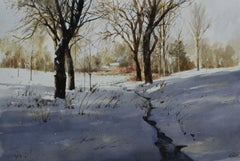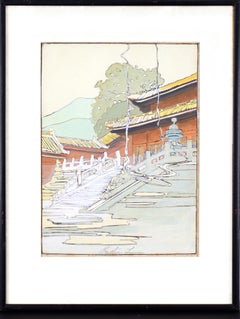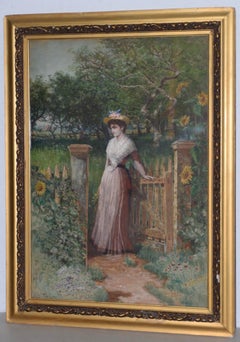
Cherry Blossom No. 12, Painting, Watercolor on Paper
View Similar Items
Want more images or videos?
Request additional images or videos from the seller
1 of 5
Elizabeth BeckerCherry Blossom No. 12, Painting, Watercolor on Paper2019
2019
About the Item
- Creator:Elizabeth Becker (1986)
- Creation Year:2019
- Dimensions:Height: 20 in (50.8 cm)Width: 16 in (40.64 cm)Depth: 0.1 in (2.54 mm)
- Medium:
- Movement & Style:
- Period:
- Condition:
- Gallery Location:Yardley, PA
- Reference Number:Seller: 1018461stDibs: LU80215518402
Elizabeth Becker
Elizabeth Becker (born 1986) is a painter living and working in Pennsylvania. At a young age, art became her therapy, both as an escape and means of expression. She went on to study fine art at Pennsylvania College of Art & Design, University of the Arts and Millersville University, where she earned her BA in Psychology and BSE in Art Education. In 2012, Elizabeth began working primarily in watercolor. She was quickly drawn to the spontaneity and immediacy of this medium. Fascinated by the beautiful and unpredictable interactions that occur between pigment, water and paper, it is an art form that she never tires of exploring. Elizabeth happily shares a simple and creative life with her husband Anthony, a woodworker, and their border collie Newman.
About the Seller
5.0
Platinum Seller
These expertly vetted sellers are 1stDibs' most experienced sellers and are rated highest by our customers.
Established in 2009
1stDibs seller since 2017
1,298 sales on 1stDibs
Typical response time: 2 hours
More From This SellerView All
- Snow in Canada_06, Painting, Watercolor on Watercolor PaperBy Helal UddinLocated in Yardley, PAThis is one of my studio paintings. I love watercolor because it’s a very challenging medium. I used Daniel Smith Extra Fine Watercolors with world-class acid-free Arches 300gsm wa...Category
21st Century and Contemporary Impressionist Drawings and Watercolor Pain...
MaterialsWatercolor
- Capistrano Under the Arch, Painting, Watercolor on Watercolor PaperBy Daniel ClarkeLocated in Yardley, PAMission San Juan Capistrano The iron bells sleep, and the trickling fountain softly murmurs prayers. The gilded church sits in the desert, an oasis of spiritual liqueur. I...Category
21st Century and Contemporary Impressionist Drawings and Watercolor Pain...
MaterialsWatercolor
- The Lonely Duck Norton Simon Gardens, Painting, Watercolor on Watercolor PaperBy Daniel ClarkeLocated in Yardley, PAWhen one is in the presence of a notable garden, the experience is gratifying and long lasting. The Norton Simon Sculpture Garden, is not only notable, but exquisite in detail. It pr...Category
2010s Impressionist Drawings and Watercolor Paintings
MaterialsWatercolor
- Balboa Park, Evening, Painting, Watercolor on Watercolor PaperBy Daniel ClarkeLocated in Yardley, PABalboa Park is a cultural oasis that includes 17 museums, gardens galore and the world-famous San Diego Zoo. At 1,200 acres, Balboa Park is one of North ...Category
21st Century and Contemporary Impressionist Drawings and Watercolor Pain...
MaterialsWatercolor
- Soweto soccer match, Painting, Watercolor on PaperLocated in Yardley, PAA pick up soccer match in the Soweto shanty town. Haunting and raw , the painting peels the cover back on the inequities of society in this powerful and emerging country. :: Paintin...Category
2010s Impressionist Drawings and Watercolor Paintings
MaterialsWatercolor
- Santa Paula Bougainvillea, Painting, Watercolor on Watercolor PaperBy Daniel ClarkeLocated in Yardley, PAThe bougainvillea wears your fragrance the scent a silent comfort in my often quiet days I enjoy our conversation while the magenta of its leaves paints a beautiful picture ...Category
21st Century and Contemporary Impressionist Drawings and Watercolor Pain...
MaterialsWatercolor
You May Also Like
- Tan Shi Sou, White Snake Temple Raised Line Woodcut Hand Painted 1924 Bertha LumBy Bertha Boynton LumLocated in Soquel, CATan Shi Sou, White Snake Temple Raised Line Woodcut Hand-Painted By Bertha Lum, 1924 Bertha Lum (American, 1869 - 1954) was fascinated by the legends and mythology of the Orient and wrote extensively about them. These legends provided the subject matter for many of her works in woodcut. Also known as 'Temple, Peking' the color woodcut by Bertha Lum was done in an edition of at least 45 impressions. She was in China on her sixth trip (1922-1924) to the Orient and her first trip to Peking where she studied Chinese woodblock printing and where she developed her "raised line" technique, such as this print. Lum would use the black "key block", printed on a sheet of thin Japanese paper and then attached to a new block. The black lines are then cut 'into' the block so they are intaglio rather than relief, like the first woodcut. Thin sheets of Oriental papers are then forced into the incised lines and a pulp is poured to strengthen the sheet. As the paper dries it shrinks and releases from the block (essentially a cast of the surface). The resultant Key Block lines are standing in relief. They are then inked with a black ink, which defines the composition. Lum then colors the surrounding areas with gouache. Each impression is uniquely colored. Because of this the image is reversed from the color woodcut. The Legend of the White Snake, also known as 'Madame White Snake', is a Chinese legend which existed in oral tradition long before any written compilation. It has since been presented in a number of major Chinese operas, films and television series. This is one of the temples in Peking that is associated with the legend. Signed at the bottom, "Bertha Lum". Presented in a black frame with a white mat. Frame size: 20.75"H x 15.75"W Image size: 14"H x 10"W Bertha Lum (1869-1954), née Bertha Boynton Bull, printmaker and illustrator, was born in Tipton, Iowa and spent her youth in Iowa and Duluth, Minnesota. In 1895, Lum attended the Art Institute of Chicago for one year, focusing on design. A few years later studied stained glass with Anne Weston and illustration at the School of Illustration with Frank Holme. In the fall of 1901 to March 1902, Lum studied figured drawing at the Art Institute of Chicago. In 1903, Bertha married Burt F. Lum, a corporate lawyer, and their honeymoon voyage to Japan in 1903 was the precursor to Bertha’s exploration of and fascination with the Orient. Returning to Japan in 1907 for fourteen weeks, she gained an introduction to Bonkotsu Igami, a master block cutter in Tokyo, who disclosed to her the techniques of carving and arranged for her education in block printing. Though married, Lum was fiercely independent and traveled for extended periods of time. Accompanied by her two young children, her 1911 sojourn in Japan lasted six months. By this time she had a thorough understanding of color woodcut and opted for the traditional division of labor. Lum moved easily within Japanese society and hers were the only foreign woodcuts in the Tenth Annual Art Exhibition in Tokyo in 1912. She was awarded the silver medal at the 1915 Panama-Pacific International Exposition and and her work was included in the 1919 Exhibition of Etchings and Block Prints at the Art Institute of Chicago. In 1921, Lum’s Summer was included in American Wood-Block Prints of Today at the New York Public Library and, in 1926, an exhibition of her work was mounted in the fall at the United States National Museum, Division of Graphic Arts. She was a member of the Asiatic Society of Japan, the California Society of Etchers, and the Print Makers Society of California. Lum authored and illustrated Gods, Goblins and Ghosts in 1922 and Gangplanks to the East in 1936. Lum was in California at the end of 1916 and moved to San Francisco in the fall of 1917, but the following years were interrupted with travel. Her most extensive stay in California was between 1924 and 1927. The 1923 earthquake in Tokyo destroyed most of her blocks and many woodcuts. Lum spent the late 1920s and the 1930s living in Peking, returning to California in 1939. She spent a great deal of time in China between the years 1948 and 1953. Bertha Lum left China to be with her daughter Catherine who lived in Genoa, Italy and she died at the age of eighty-four years old in February 1954. Bertha Boynton Lum is represented in the collections of the Brooklyn Museum, New York; the Art Institute of Chicago and the Terra Foundation for American Art, Chicago; the Jordon Schnitzer Museum of Art, University of Oregon, Eugene; the Amon Carter Museum of American Art, Fort Worth, Texas; the British Museum, London; the Los Angeles County Museum of Art, California; the Zimmerli Art Museum, Rutgers, New Brunswick, New Jersey; the Metropolitan Museum of Art, New York; the Portland Art Museum, Oregon; the Fine Arts Museums of San Francisco, California; the Library of Congress and the National Museum of Women in the Arts, Washington, D.C.; and the Delaware Art Museum, Wilmington. Bertha Boynton Lum was an American artist known for helping popularize the Japanese and Chinese woodblock print outside of Asia. In May 1869, Lum was born as Bertha Boynton Bull in Tipton, Iowa. Lum's father was Joseph W. Bull (1841–1923), a lawyer and her mother was Harriet Ann Boynton (1842–1925), a school teacher. Both of Lum's parents were amateur artists. Lum had a sister and two brothers, Clara, Carlton, and Emerson. Education and career: In 1890 she lived in Duluth and listed her occupation as artist. She enrolled in the design department of the Art Institute of Chicago in 1895. A few years later she studied stained glass with Anne Weston and attended the Frank Holme School of Illustration. From November 1901 to March 1902, she studied figure drawing at the Art Institute of Chicago and was influenced by the Japanese techniques of Arthur Wesley Dow in his book Composition, which was published in 1899. Lum married Burt F. Lum, a corporate lawyer from Minneapolis, Minnesota, in 1903. They spent their seven-week honeymoon in Japan, where she searched for a print maker who could teach her the traditional ukiyo-e method. Toward the end of her stay in Japan, she found a shop that reproduced old prints. The shop sold her some woodcutting tools...Category
1920s American Impressionist Figurative Drawings and Watercolors
MaterialsGouache, Rice Paper
- A.D. Turner Watercolor Portrait of a Young Woman at Gardens Gate c.1910Located in San Francisco, CAEarly 20th C. Watercolor Portrait of an Elegant Young Woman at Gardens Gate c.1910 Absolutely beautiful watercolor by A.D. Turner. This elegant young woman stands in a country lands...Category
Early 20th Century Impressionist Figurative Drawings and Watercolors
MaterialsWatercolor
- Landscape Water Colour by Emil Kosa JrBy Emil Kosa Jr.Located in Pasadena, CAEmil Kosa, Jr., N.A. (1903-1968) Born: Paris, France; Studied: Academy of Fine Arts (Prague), Ecole des Beaux Arts (Paris), Chouinard Art Institute (Los Angeles); Member: National Ac...Category
1930s American Impressionist Figurative Drawings and Watercolors
MaterialsOil, Watercolor
- Early 1900's French Impressionist Signed Flower Watercolour by Marie CarreauLocated in Cirencester, Gloucestershire"Flowers" by Marie-Amelie Chautard-Carreau (French, 19th/20th century) signed bottom right watercolour on paper, unframed painting: 9.75 x 14.75 inches Delightful early 20th centur...Category
Early 20th Century Impressionist Still-life Paintings
MaterialsWatercolor
- Original Ronald Shap figure drawing, signedLocated in Columbus, OHOriginal gouache and oil pastel figure drawing by celebrated, twentieth-century California impressionist landscape painter, Ronald Shap. Nude woman laying sideways with washes of tea...Category
1980s Impressionist Nude Drawings and Watercolors
MaterialsGouache, Oil Pastel
- "Train Station, " Max Kuehne, Industrial City Scene, American ImpressionismBy Max KuehneLocated in New York, NYMax Kuehne (1880 - 1968) Train Station, circa 1910 Watercolor on paper 8 1/4 x 10 1/4 inches Signed lower right Provenance: Private Collection, Illinois Max Kuehne was born in Halle, Germany on November 7, 1880. During his adolescence the family immigrated to America and settled in Flushing, New York. As a young man, Max was active in rowing events, bicycle racing, swimming and sailing. After experimenting with various occupations, Kuehne decided to study art, which led him to William Merritt Chase's famous school in New York; he was trained by Chase himself, then by Kenneth Hayes Miller. Chase was at the peak of his career, and his portraits were especially in demand. Kuehne would have profited from Chase's invaluable lessons in technique, as well as his inspirational personality. Miller, only four years older than Kuehne, was another of the many artists to benefit from Chase's teachings. Even though Miller still would have been under the spell of Chase upon Kuehne's arrival, he was already experimenting with an aestheticism that went beyond Chase's realism and virtuosity of the brush. Later Miller developed a style dependent upon volumetric figures that recall Italian Renaissance prototypes. Kuehne moved from Miller to Robert Henri in 1909. Rockwell Kent, who also studied under Chase, Miller, and Henri, expressed what he felt were their respective contributions: "As Chase had taught us to use our eyes, and Henri to enlist our hearts, Miller called on us to use our heads." (Rockwell Kent, It's Me O Lord: The Autobiography of Rockwell Kent. New York: Dodd, Mead and Co., 1955, p. 83). Henri prompted Kuehne to search out the unvarnished realities of urban living; a notable portion of Henri's stylistic formula was incorporated into his work. Having received such a thorough foundation in art, Kuehne spent a year in Europe's major art museums to study techniques of the old masters. His son Richard named Ernest Lawson as one of Max Kuehne's European traveling companions. In 1911 Kuehne moved to New York where he maintained a studio and painted everyday scenes around him, using the rather Manet-like, dark palette of Henri. A trip to Gloucester during the following summer engendered a brighter palette. In the words of Gallatin (1924, p. 60), during that summer Kuehne "executed some of his most successful pictures, paintings full of sunlight . . . revealing the fact that he was becoming a colorist of considerable distinction." Kuehne was away in England the year of the Armory Show (1913), where he worked on powerful, painterly seascapes on the rocky shores of Cornwall. Possibly inspired by Henri - who had discovered Madrid in 1900 then took classes there in 1906, 1908 and 1912 - Kuehne visited Spain in 1914; in all, he would spend three years there, maintaining a studio in Granada. He developed his own impressionism and a greater simplicity while in Spain, under the influence of the brilliant Mediterranean light. George Bellows convinced Kuehne to spend the summer of 1919 in Rockport, Maine (near Camden). The influence of Bellows was more than casual; he would have intensified Kuehne's commitment to paint life "in the raw" around him. After another brief trip to Spain in 1920, Kuehne went to the other Rockport (Cape Ann, Massachusetts) where he was accepted as a member of the vigorous art colony, spearheaded by Aldro T. Hibbard. Rockport's picturesque ambiance fulfilled the needs of an artist-sailor: as a writer in the Gloucester Daily Times explained, "Max Kuehne came to Rockport to paint, but he stayed to sail." The 1920s was a boom decade for Cape Ann, as it was for the rest of the nation. Kuehne's studio in Rockport was formerly occupied by Jonas Lie. Kuehne spent the summer of 1923 in Paris, where in July, André Breton started a brawl as the curtain went up on a play by his rival Tristan Tzara; the event signified the demise of the Dada movement. Kuehne could not relate to this avant-garde art but was apparently influenced by more traditional painters — the Fauves, Nabis, and painters such as Bonnard. Gallatin perceived a looser handling and more brilliant color in the pictures Kuehne brought back to the States in the fall. In 1926, Kuehne won the First Honorable Mention at the Carnegie Institute, and he re-exhibited there, for example, in 1937 (Before the Wind). Besides painting, Kuehne did sculpture, decorative screens, and furniture work with carved and gilded molding. In addition, he designed and carved his own frames, and John Taylor Adams encouraged Kuehne to execute etchings. Through his talents in all these media he was able to survive the Depression, and during the 1940s and 1950s these activities almost eclipsed his easel painting. In later years, Kuehne's landscapes and still-lifes show the influence of Cézanne and Bonnard, and his style changed radically. Max Kuehne died in 1968. He exhibited his work at the National Academy of Design, the Art Institute of Chicago, the Carnegie Institute in Pittsburgh, the Memorial Art Gallery of the University of Rochester, and in various New York City galleries. Kuehne's works are in the following public collections: the Detroit Institute of Arts (Marine Headland), the Whitney Museum (Diamond Hill...Category
1910s American Impressionist Landscape Drawings and Watercolors
MaterialsPaper, Watercolor
